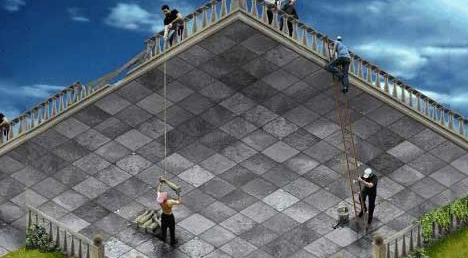Optical illusion is as old as mankind. It is practically all around us. It gives us a distorted sense of perception. It seems our brain cannot decipher what the eye can see.
Optical illusion or visual illusion
This phenomenon happens when the brain and the eye cannot seem to agree on the stimuli. Or the information feed by the eye and perceived by the brain. Objects will look different from the objective reality. A pen for instance when half immersed in water will look as if broken in two. The negative image we often see after staring at the sun is a form of optical illusion. It is like seeing things slightly different from the actual images. In man-made structures for instance, optical illusion is tempered. Some refinements are made to correct the distortion. This is applied to give the structure a visual rendition as natural as possible.
Optical illusion in structures are often seen as: (1) long horizontal parapets seems to sag at the center; (2) vertical columns seem to lean outward; and (3) corner columns often look smaller or thinner when viewed against adjacent pillars of the same size. All of these distortions give onlookers disconcerting feelings. As if the designers and builders failed in their craft. This will look really alarming to most. But, for those familiar with optical illusion will just shrug-off whatever is visually upsetting.
The Greeks actually taught the world refinements to correct optical illusion and designers had benefited from it. Not just the Romans who came after the Greeks, but to Michaelangelo and the Renaissance, up to Walter Gropius and the modern movement. Three of the refinements are the following:
- Greek structures of the past are often characterized by long flowing horizontal lines. This is seen in the entablatures, the steps of the Stoa and several others. Because the structures are mammoths in scale, the long horizontal stringcourses are seen to sag at the center. To correct the visual distortion, Greek artisans purposely curved and raised the center. Thus, when viewed, it looks normal and straight to the naked eye.
- The columns of the Parthenon are constructed to lean at a degree inwards. This correction has to be implemented to correct the feeling of columns falling outwards. In particular when the columns are viewed from the steps of the Stoa.
- The corner columns of buildings are designed slightly bigger or larger. This is to correct the impression of columns appearing smaller when viewed against the sky. Optical illusion dazzles, columns viewed against a dark background looks bigger in comparison.
Although, there are other refinements introduced to temper the effects of optical illusion, none are more pronounced than the above mentioned.
Next time a structure seems visually appealing, the refinements has perfectly added the dimension to correct optical illusion.


No comments:
Post a Comment